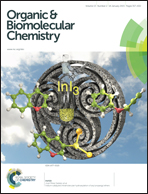Naphthalene diimides as red fluorescent pH sensors for functional cell imaging†
Abstract
A small library of hydrosoluble naphthalene diimides (NDIs) was designed and synthesized, as cell permeable pH “turned-on” fluorescent sensors, for cellular applications. The NDIs exhibit a non-emitting twisted intramolecular charge transfer (TICT) state, which has been described by a DFT computational investigation. These NDIs do not emit as a free base, but they become strong emitters when protonated. Switching of the red emission was achieved in the pH window 2.5–6, tuning steric and electronic features of the amine moiety. The least acidic protonated NDI 5 (pKa 5.1), was investigated in normal and cancer cells. Its selective redistribution in cancer cells from acidic vesicular organelles to the cytoplasm and the nucleus describes an effective application of these NDIs as a valuable functional tool.


 Please wait while we load your content...
Please wait while we load your content...